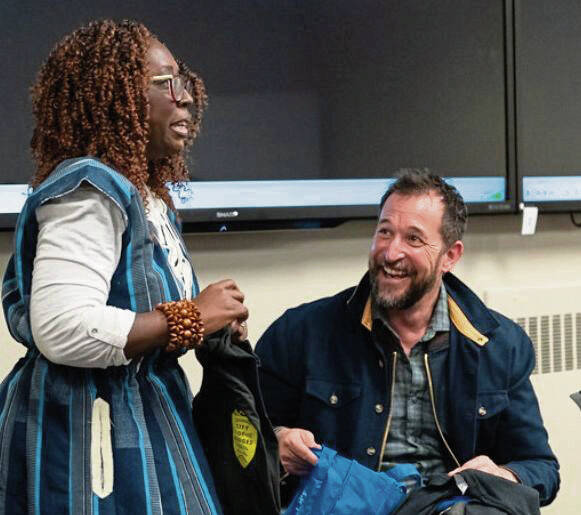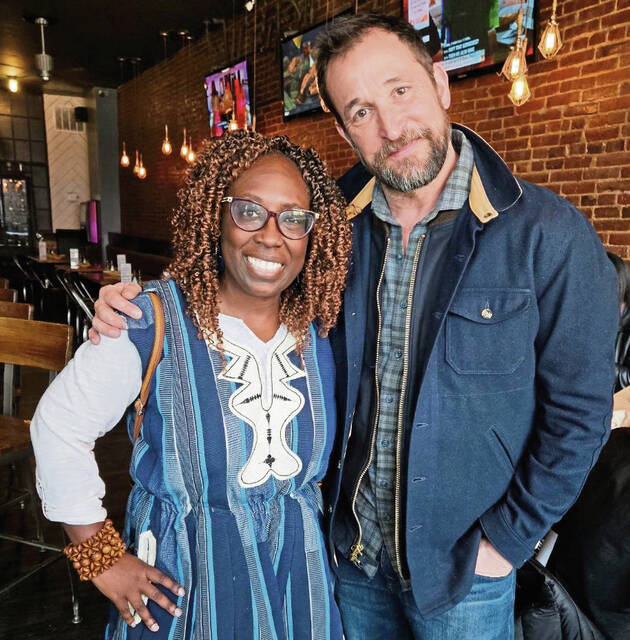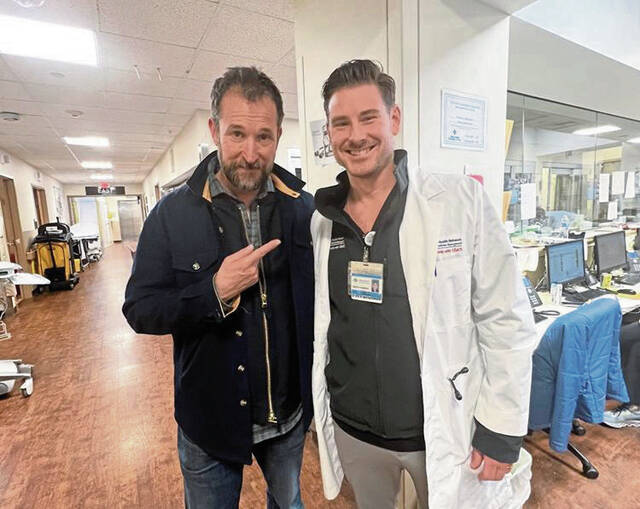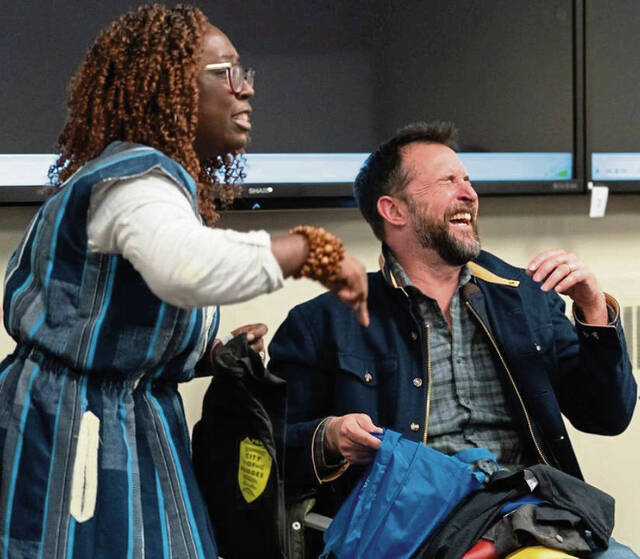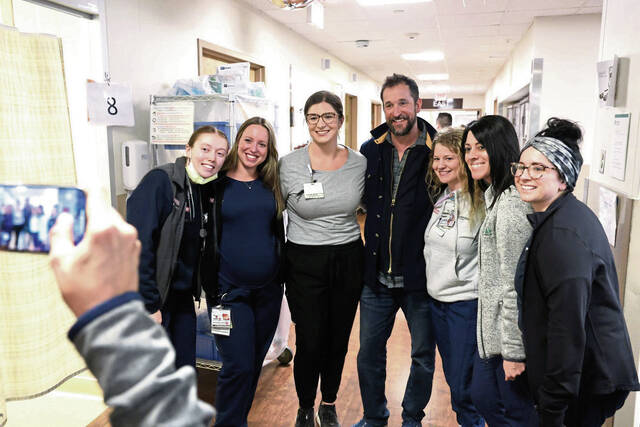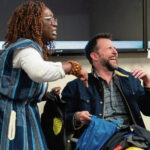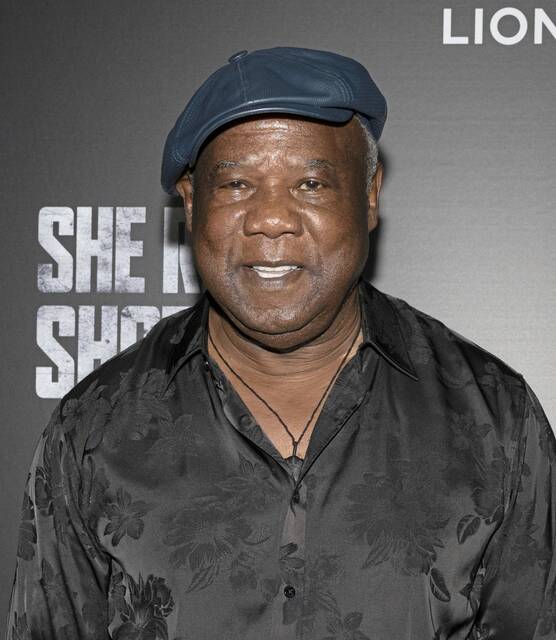For staff in the Allegheny General Hospital emergency room, Max’s Pittsburgh-set “The Pitt” isn’t just a TV show, but an education for friends and family about the work they do every day.
“These aren’t things we actually talk about with our golf group or friends group or at the dinner table,” said Kathy Sikora, a registered nurse and director of emergency services at AGH. “You get texts every week: ‘Did that really happen? Does that happen? Is it really like that?’ It’s an opportunity to really get a good inside look at what we all do. … This is the (show) where you can say, ‘That was my Tuesday.’ ”
“The Pitt,” streaming new episodes at 9 p.m. Thursdays on Max through April 10, stars Noah Wyle as Dr. Michael “Robby” Robinavitch, the chief attending doctor in Pittsburgh Trauma Medical Center’s emergency department.
“The Pitt” filmed for seven months on soundstages at Warner Bros. in Burbank, Calif., but came to Pittsburgh for a week of location shooting in September, mostly at AGH, which plays the exterior of the fictional PTMC. (Sikora said Wyle told her on his visit to AGH in February — as part of an East Coast press tour — that the show will return to film scenes locally in September for its already-ordered second season.)
“A lot of my family has actually said, ‘Is that what your waiting room looks like?’ ” said Patricia Agnello, a registered nurse and nighttime nursing supervisor in AGH’s ER. “And I said, ‘Aesthetically, or as far as all those people?’ And they said, ‘No, all those people (in the waiting room).’ Yes, it absolutely is. They were amazed. They never comprehended just how it is in the ER.”
Chris Morris, an AGH ER physician, said “The Pitt” is the first and only TV medical drama he’s watched, in part because it filmed at AGH, but he’s also enjoyed it, at least to the extent that one can, given his job.
“It feels like coming home and watching what I do in real life,” said Morris, who provided medical oversight when “The Pitt” filmed a scene in the third episode outside of AGH in September. He offered expertise on the appropriate way to administer Narcan.
Related
• TV Talk: Joseph Cannon, Pittsburgh broadcaster's son, stars in Lifetime movie
• TV Talk: Why so many national news anchor changes?
• TV Talk: 'Born Again' picks up Daredevil's story, brings it to Disney+
Several AGH doctors said past medical shows, including “ER” and “Grey’s Anatomy,” featured too much melodrama to ring true-to-life.
“The only other show that I’ve watched in its entirety and enjoy is (the NBC comedy) ‘Scrubs,’ because it really gets that interaction between providers with some levity in it,” said Benjamin V. Thomas, chief resident in AGH’s ER. “(‘The Pitt’) has gotten a lot of the medical information correct. It gets a lot of the day-to-day tasks of things that we do right, including talking with families, talking with consultants, trying to manage these high-acuity patients and trying and get them out the door while also stabilizing them enough to get them to an ICU or to the operating room.”
Thomas said he’s noticed only a few mistakes, such as when a character was putting a scopolamine patch (used to prevent nausea) on an elderly pneumonia patient: “He wasn’t wearing a glove,” Thomas observed. “He was touching the medication with his hand.”
Amanda Morgan-Beal, a physician assistant at Armstrong County Memorial Hospital, said the depiction of an ER in post-covid times in “The Pitt” rings true, especially the lack of available beds, wait times and an administrator coming into the ER to discuss Press Ganey scores. (Those are ratings based on surveys sent to patients after they leave the hospital.)
“It turns medicine into customer service,” she said of the surveys. “If you’re not giving the patient what they want — opioids, antibiotics — you can get a very poor Press Ganey score, which is very unfair. It makes you have to pick between practicing medicine ethically and working on getting a good Press Ganey score.”
Morgan-Beal said the medical jargon used when doing procedures is “exactly what happens.” Details such as where to make an incision for a chest tube are shown accurately.
Sikora, the AGH emergency services director, said she especially appreciates that the show is shining a light on the need for ER security and excessive waiting room times. While she does not believe that any of “our leaders would come down to the emergency department on a busy day and talk to us about Press Ganey scores,” she believes the show is “talking about it just to draw attention to all the other pressures that we’re under.”
In the view of Morris, the AGH ER physician, “They’re just putting those conversations out there — and those are real conversations that we’re having — and letting people know that is very important.”
Morgan-Beal does have one specific criticism of the show: the absence of any physician assistant characters, something she wants the show’s writers to rectify in season two.
“There are almost 200,000 physician assistants in the U.S., and we are a crucial and integral part of the ER team,” she said. “There’s a physician shortage to begin with. When you couple that with the wait times, patients sitting in hallways and waiting rooms, that’s where PAs fill in the gaps. I don’t know any ERs that don’t staff PAs because they’re so needed.”
PAs are licensed clinicians who practice medicine in many settings. PAs require less education than doctors, “which impacts their scope of practice and level of autonomy,” per New York’s University of Medicine and Health Sciences. But PAs do many of the same tasks as doctors.
“When they are seasoned in the ER, they are training residents or interns coming in,” Morgan-Beal said. “A couple months ago I taught a doctor how to do a procedure she had never done. It’s a team effort.”
She hopes “The Pitt” writers will consider adding PAs, which could also be story fodder.
In one espisode, a hospital administrator says “they don’t have the money to bring in more staff,” Morgan-Beal said. “Well, then bring in PAs, who are typically paid less than physicians doing about the same job.”
On Wyle’s recent visit, he told Sikora the show has been criticized by viewers from a few specialty areas, including for the lack of respiratory therapists.
“But overall, it’s doing a great job,” Sikora said. “They can’t show everything every time.”
“The Pitt” writers did extensive consultation with doctors prior to scripting the show’s first season. At least three were from Pittsburgh, with ties to UPMC and/or the University of Pittsburgh School of Medicine: Dr. Shelia Roth, regarding social work care; Dr. Ron Roth, on EMS care; and Dr. Sylvia Owusu-Ansah, who works in pediatric emergency medicine.
Owusu-Ansah said the writers asked which important issues in health care need to be portrayed or have yet to be depicted in a TV show.
Among her responses:
• The importance of highlighting health disparities, particularly regarding patients with sickle cell disease.
• Bias surrounding pain management — specifically, the distinction between legitimate pain management needs and the perception of pain-seeking behavior.
• Concerns about the increasing intake of marijuana and THC gummies among children.
• The Black EMS pioneers from the Hill District’s Freedom House Ambulance Service.
• The use of the LUCAS device in EMS — a mechanical chest compression system that assists health care providers in performing CPR on patients in cardiac arrest.
• Patients with vitamin C deficiency and scurvy.
• Observing a moment of silence to honor patients who have just died.
All of those topics worked their way into episodes of “The Pitt.”
“I shared insights about being the only Black physician in the pediatric emergency department at a top children’s hospital, noting that only 5% of the active physician workforce is Black, compared to around 12 to 13% of the national population,” Owusu-Ansah said. “This context was important, especially in relation to Dr. Collins,” a Black character played by Tracy Ifeachor.
Owusu-Ansah also “recounted a touching moment with an African American family member who referred to me as ‘my queen’ when I entered the room,” which was used as dialogue a patient speaks to Dr. Collins in the sixth “Pitt” episode (“12:00 p.m.,” which debuted Feb. 6).
Appreciation of “The Pitt” is not limited to medical professionals.
Amy Bray, who works as a customer operations manager in Tacoma, Wash., said “The Pitt” helped her as she was preparing for the death of a close family member. She remembered a scene from “The Pitt” where Dr. Robby named the four things a person should say to someone who is dying: “I love you. Thank you. I forgive you. Please forgive me.”
“I was able to say those things and am forever grateful,” Bray said. “I am very thankful I was able to see that episode before I had to say goodbye.”



